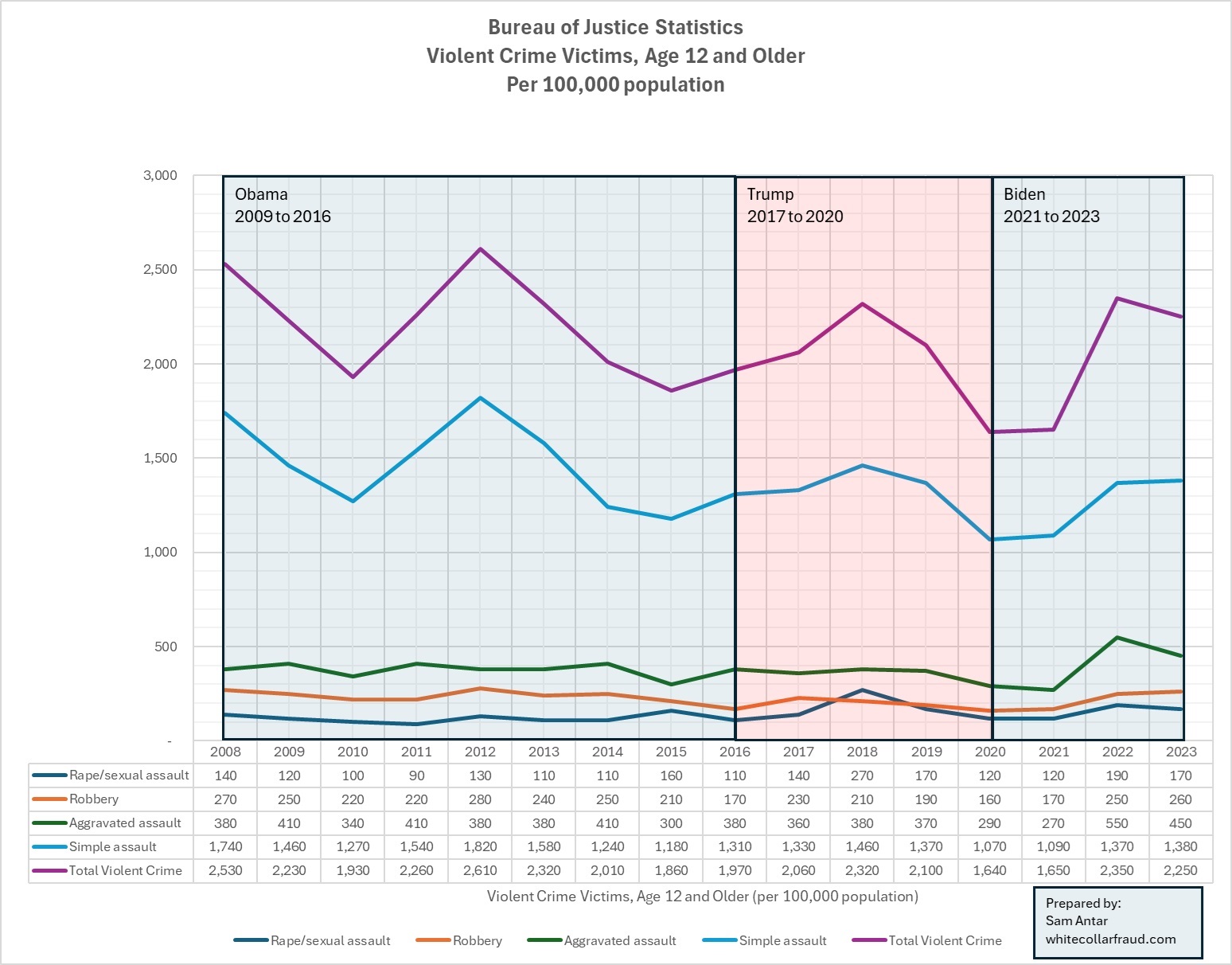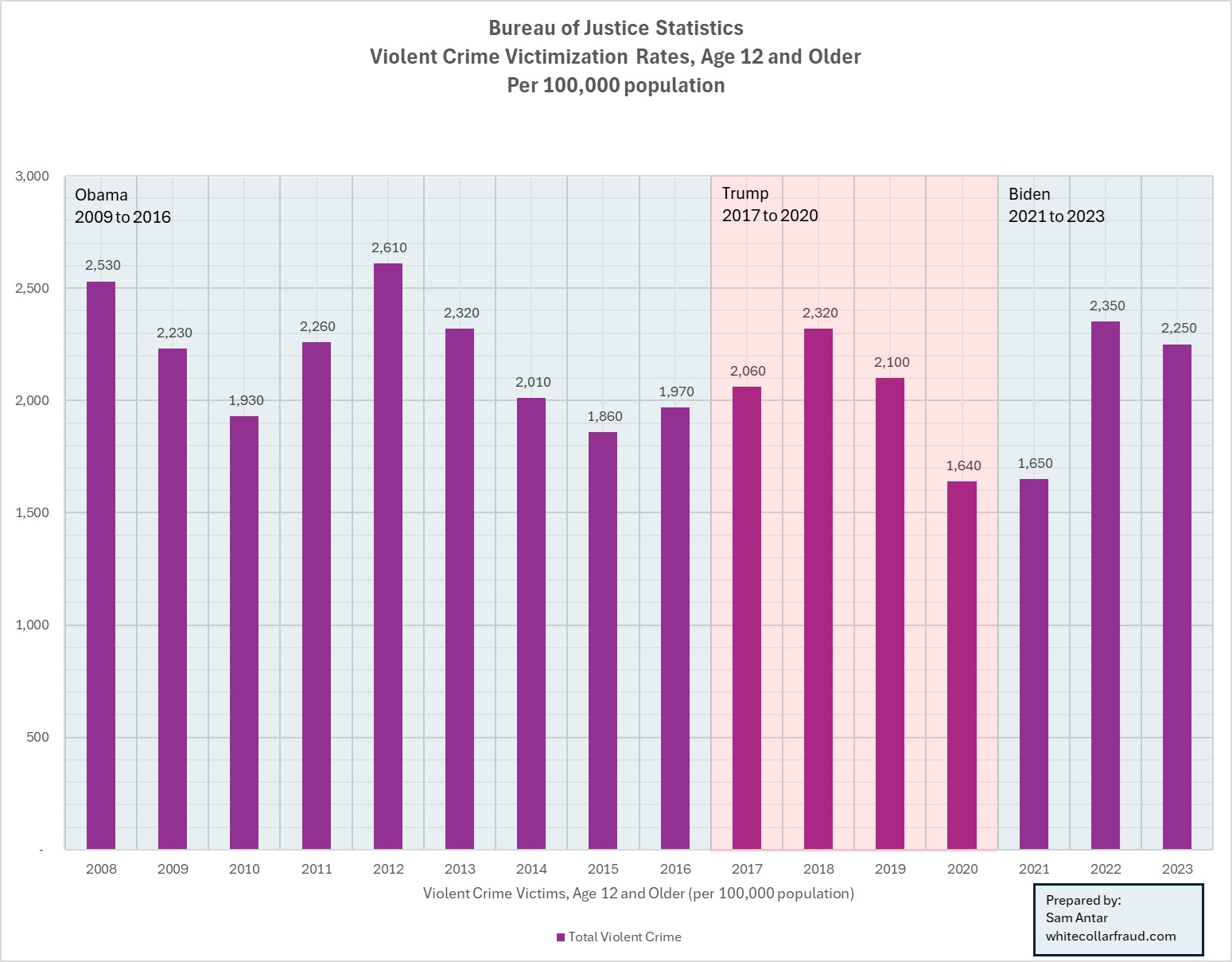Introduction
In the realm of political discourse, few topics generate as much heated debate as crime rates. As we navigate through different presidential administrations, it’s crucial to examine the data objectively and understand the trends that have shaped our nation’s safety landscape. This analysis delves into the violent crime statistics spanning the Obama, Trump, and Biden administrations, using data from the National Crime Victimization Survey (NCVS).
The findings reveal a dismal state of affairs, particularly damning for the current administration. President Biden confronts an insurmountable challenge: to merely equal the subpar performance of his predecessor, his administration would need to orchestrate a staggering 16.9% reduction in violent crime rates in 2024 alone. This monumental task underscores the gravity of the current crime crisis and the persistent failure of recent administrations to effectively combat public safety concerns.
This analysis will methodically deconstruct the violent crime trends under each administration, illuminating their specific shortcomings and challenges. It will also elucidate why the National Crime Victimization Survey data provides a more comprehensive picture than the oft-cited FBI statistics, offering a nuanced perspective on the true state of violent crime in America.
Why Not FBI Data?
Before we delve into the numbers, it’s imperative to address why this analysis doesn’t rely on the more commonly cited FBI Uniform Crime Reporting (UCR) program. The FBI’s data, while widely recognized, suffers from significant limitations that render it inadequate for a comprehensive analysis:
- Severe Underreporting: The UCR only includes crimes reported to law enforcement, ignoring a substantial number of incidents that victims, for various reasons, choose not to report.
- Inconsistent Data Collection: Not all law enforcement agencies consistently report their data to the FBI, leading to glaring gaps in coverage and potential inaccuracies in national estimates.
- Narrow Scope: The UCR’s focus on a limited set of crimes potentially blinds us to broader trends in criminal activity.
- Vulnerability to Policy Manipulation: Changes in local policing policies or reporting practices can significantly skew UCR numbers without reflecting actual changes in crime rates.
- Delayed Reporting: The FBI’s comprehensive crime report is typically released with a significant lag, making it less useful for analyzing recent trends.
Moreover, the fundamental differences between the UCR and the National Crime Victimization Survey (NCVS) make direct comparisons problematic:
- Differing Crime Categories: The UCR includes murder, non-negligent manslaughter, and commercial crimes (such as burglary of commercial establishments), which the NCVS excludes. It’s crucial to note that the NCVS’s omission of murder and non-negligent homicide is a significant limitation, as these crimes represent the most severe form of violence in our society. Conversely, the UCR excludes sexual assault, which the NCVS includes. Critically, the NCVS also includes simple assaults, which are absent from the FBI UCR numbers, providing a more comprehensive picture of less severe, but still impactful, violent crime.
- Age Limitation: The NCVS only includes crime victims aged 12 or older, potentially undercounting crimes against children but providing a consistent demographic for long-term trend analysis.
- Incompatible Measurement Units: The UCR reports property crime rates per person, while the NCVS reports them per household. This discrepancy, coupled with potentially different growth rates of households versus total population, makes trend comparisons for property crimes particularly unreliable.
- Methodological Disparities: Even when restricting the NCVS to violent crimes reported to police and excluding simple assault to align more closely with the UCR, significant methodological and definitional differences persist.
These disparities preclude complete congruity between the UCR and NCVS. Despite its limitations, the NCVS provides a more comprehensive picture of most crime trends due to its broader scope and consistent methodology. It stands as the superior choice for analyzing violent crime trends across administrations, offering insights into unreported crimes and everyday violence often overlooked by FBI data. However, the NCVS’s exclusion of murder and non-negligent homicide is a significant blind spot. For a complete understanding of violent crime, especially the most severe offenses, UCR data on these crimes must be considered alongside the NCVS.
The Damning Numbers: A Race to the Bottom
The data illustrates the violent crime victimization trends under the Obama, Trump, and Biden administrations. The numbers paint a grim picture of America’s struggle with violent crime and serve as a stark reminder of the consistent failure of our nation’s leaders to protect its citizens.
Breaking Down the Failures
This data paints a picture of persistent failure across three administrations to adequately address violent crime in America. The Obama administration’s volatility, Trump’s stagnation, and Biden’s post-pandemic surge all represent squandered opportunities to make our nation safer.
Comparative Analysis
A breakdown of the average total violent crime rates for each administration, considering all available data, reveals:
- Obama’s tenure (2009-2016): Average total violent crime rate of 2,148.8 per 100,000.
- Trump’s full term (2017-2020): Average of 2,030.0 per 100,000, including the anomalous 2020.
- Biden’s partial term (2021-2023): Average of 2,083.3 per 100,000, including the transition year of 2021.
Nuanced Interpretation
These averages provide a more incisive picture of the crime landscape:
- Obama’s administration had the highest average, reflecting the volatility and overall high crime rates during his tenure.
- Trump’s average appears lower, largely due to the inclusion of 2020, when crime rates dropped significantly due to pandemic-related lockdowns. Excluding 2020, Trump’s average rises to 2,160 per 100,000, slightly surpassing Obama’s.
- Biden’s average, while lower than Obama’s, is skewed by the inclusion of 2021, which saw unusually low crime rates as pandemic restrictions persisted in many areas. Excluding 2021, Biden’s average spikes to 2,300 per 100,000, the highest of all three administrations.
The Pandemic Effect
These figures underscore a troubling trend of persistent and, in some cases, worsening violent crime rates across administrations. The inclusion of 2020 and 2021 in our analysis serves as a stark reminder of how external factors can dramatically impact crime rates, but it doesn’t alter the fundamental narrative of governmental failure to effectively address violent crime.
Biden’s Uphill Battle
Looking ahead, the outlook for the Biden administration appears particularly bleak:
- To match Trump’s average (including 2020): Biden’s administration would need to reduce the violent crime rate to 1,870 per 100,000 in 2024, representing a staggering 16.9% decrease from the 2023 rate of 2,250 per 100,000.
- Excluding anomalous years: Even if we exclude the pandemic-influenced years of 2020 and 2021, Biden would need to reduce the violent crime rate to 1,880 per 100,000 in 2024 – a 16.4% decrease from 2023 – to match Trump’s adjusted average of 2,160 per 100,000.
These scenarios paint a dismal picture for the Biden administration, no matter how the data is analyzed. The required decrease in violent crime rates is not only statistically improbable but would also demand a level of policy effectiveness that has been glaringly absent thus far.
A Low Bar for Success
It is crucial to note that even if Biden’s administration were to achieve these drastic reductions, it would merely be bringing crime rates in line with the already high levels seen under Trump – hardly a benchmark of success in ensuring public safety.
The Need for Radical Change
The time for excuses has long passed. Our communities deserve better, and it is high time our leaders delivered on their promises to create a safer nation for all. Each administration has failed in its own way to adequately address the scourge of violent crime, leaving American citizens to bear the brunt of their ineffective policies and empty rhetoric.
The Biden administration, in particular, faces an uphill battle that borders on the impossible. The likelihood of achieving the necessary reduction in crime rates to even match the mediocre performance of previous administrations is extremely low. This stark reality serves as a damning indictment of not just the current administration, but of the entire political establishment’s approach to crime and public safety over the past decade and a half.
As we look to the future, it is abundantly clear that a radical reimagining of crime prevention and community safety strategies is desperately needed. The status quo has failed, and the American people continue to pay the price for this failure in fear, insecurity, and shattered lives.
Written by,
Sam Antar
© Copyright by Sam Antar. All rights reserved.

